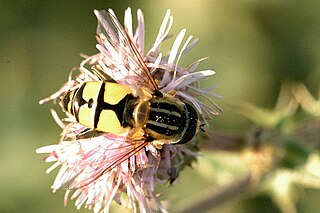
Helophilus hybridus is a hoverfly. It is a Palearctic species.

Eristalis intricaria is a European species of hoverfly. It is a furry bee mimic, superficially resembling Merodon, though Merodon have all black leg tibiae, as opposed to partly yellow. E. intricaria is somewhat variable in colour pattern, and some attempts at naming varieties have been tentatively made. Flight time of adults in the UK are from March to September. It is generally widespread, but is seldom seen in large numbers. Habitat is woodland or marshland.

Eupeodes corollae is a very common European species of hoverfly. Adults are 6–11 millimetres (0.24–0.43 in) in body length. Males and females have different marking on the abdomen; males have square commas on tergites 3 and 4, whereas females have narrow commas. Larvae feed on aphids. This species has been used experimentally in glasshouses as a method of aphid control, and to control scale insects and aphids in fruit plantations. They were found to be partial to the fruit, eating more fruit than aphids.

Merodon equestris is a Holarctic species of hoverfly. Like many other hoverflies it displays a colouration pattern similar to a stinging insect as an evolutionary defense mechanism. Other syrphid bee mimics are Mallota, Arctophila, Criorhina, Pocota and Brachypalpus. Merodon species are distinguished from these by the very strong hind femora, which bear a large triangular projection on the underside near the tip. It flies in low vegetation while the other bumblebee mimics prefer higher vegetation layers.

Leucozona laternaria is a European species of hoverfly.

Parasyrphus punctulatus is a Palearctic species of hoverfly.

Criorhina berberina is a species of hoverfly. It is found in the Palaearctic from Fennoscandia South to Iberia and Italy. Ireland eastwards through Europe into Turkey and European Russia . C. berberina is a bumblebee mimic. The body has uniformly long dense pubescence, obscuring the ground-colour. There are two forms one with the pubescence more or less extensively blackish, one in which it is entirely yellow or tawny. Criorhina differ from other bumblebee mimics - Mallota, Arctophila, Pocota and Brachypalpus by the form of their antennae: the first segments are thin and form a stalk, the third segment is shorter than it is wide. In Criorhina, the face projects downwards, in contrast to Pocota and Brachypalpus.
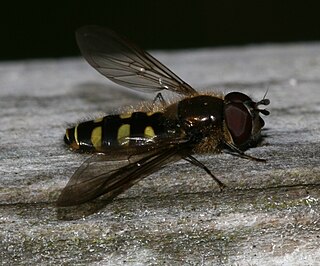
Melangyna lasiophthalma is a Holarctic species of hoverfly.

Eriozona syrphoides is a European species of hoverfly. A large, bee mimic The thorax has black hairs in the middle and yellow or reddish hairs on the front and hind margins. The scutellum is white to yellow with yellow hairs. The abdomen has white hairs in front, black in the middle and has red hairs at the tip. The wing has a dark patch. The habitat is Picea, Abies forest. It is arboreal descending to feed on white umbellifers, Centaurea, Cirsium, Crataegus, Epilobium, Hypericum, Ranunculus, Sambucus nigra, Sorbus aucuparia, Succisa, Valeriana. It ranges from Fennoscandia south to France and from Ireland eastwards through Central Europe and northern Italy into European Russia and the Russian Far East and on through Siberia to the Pacific coast. The larva feeds on aphids.

Syrphus torvus, the Hairy-eyed Flower Fly, is a common species of hoverfly found in the Holarctic. The adults feed on pollen and nectar, but the larvae feed on aphids.

Epistrophe grossulariae is a Holarctic species of hoverfly.

Criorhina floccosa, is a species of hoverfly. It is found in many parts of the Palearctic including Europe.
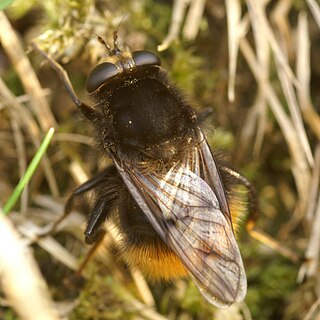
Criorhina ranunculi, is a species of hoverfly found in the spring in many parts of Britain and Europe.
Melangyna arctica is a Holarctic species of hoverfly.

Cheilosia nebulosa is a Palearctic species of hoverfly.

Megasyrphus erraticus is a Holarctic species of hoverfly associated with mature conifer woodlands and plantations.

Orthonevra geniculata is a species of hoverfly found in the Palearctic.
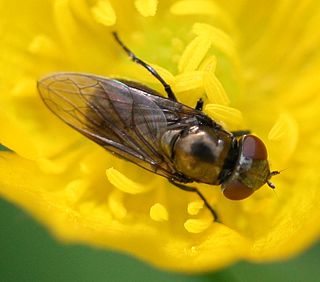
Chrysogaster virescens is a European species of hoverfly.
Chrysotoxum fasciatum is a species of Holarctic hoverfly.
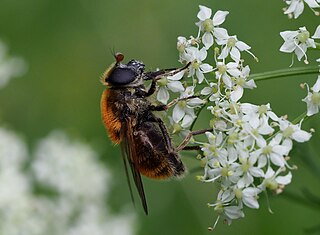
Cheilosia chrysocoma is a European species of hoverfly.


















